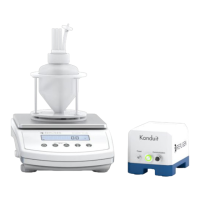41
eRev. [Major Version]1.01.0 8/9/2023
KrosFlo® KR2i Real-Time Process Management (RPM™) System
11. Basic Concepts of Tangential Flow Filtration
11.1 Introduction
Membranes use the principle of barrier separations to differentiate components based on size. Components larger than the
membrane pore are held back by the membrane while smaller components pass through the membrane structure along with the
permeate. Although there are other methods for driving the separation process, Repligen’s hollow fiber TFF modules are designed
for pressure-driven applications.
Tangential Flow Filtration is an efficient way to separate streams that would quickly become plugged if processed by dead-end
filtration techniques. Most of the process fluid flows along the membrane surface, rather than passing through the membrane
structure. Fluid is pumped at a relatively high velocity parallel to the membrane surface.
Except for water treatment applications, only a small percentage of the tangential flow along the membrane surface ends up as
permeate. In most cell and particle separations, only 1–5% of the inlet flow to the membrane device becomes permeate. The
remaining 95–99% exits the membrane device as retentate. The retentate is recirculated back to the process reservoir and the
module inlet so that another 1–5% can be removed as permeate. This recirculation process continues in rapid succession, generating
a significant and continuous permeation rate.
Filtrate flow results in a buildup of retained components on the membrane’s inner lumen surface; these may occasionally
accumulate into a cake layer instead of being carried away by the sweeping action of the recirculation fluid. This cake layer becomes
a membrane barrier, reducing the functional size of the membrane pore and affecting module performance.
Caking is influenced by several fluid variables: degree of solvation, concentration and nature of the solids and solutes, fluid
temperature, along with operating variables—such as the solution’s velocity along the membrane—and TMP. Controlling this
phenomenon by ensuring adequate fluid velocity at the liquid-membrane wall interface will maximize flux, solute passage, and
optimize process parameters. Fluid velocity is controlled by the pumping rate. Pumping rate depends on the quantity of fibers in the
module and shear rate considerations. Typically, a shear rate of 12000 s
-1
is used for filtration applications and up to 4000 s
-1
is used
for perfusion applications. However, some certain applications work well at reduced rates while others may require rates that are
significantly higher. These are the considerations that the user usually investigates during Research and Development prior to
moving to Pilot phase for their applications.
11.2 Concentration
Concentration is the reduction of the initial sample volume to a lower, final sample volume. For example, if the process volume is
10 L and needs to be concentrated to 10X, then the final sample volume will be 1 L. The opposite would be a dilution, where the
initial sample volume is increased to the final sample volume through the addition of buffer or other medium.
The in-line variable pathlength technology (VPT) spectrophotometer monitors concentration directly in the flow path using
absorbance spectroscopy. The VPT device uses the Beer-Lambert law, = , to measure the absorbance A at various pathlengths
l, and then calculate concentration c based on the given extinction coefficient ε. The concentration value is communicated to the TFF
system in real time during the process, allowing the system to recognize when the sample has reached the desired concentration.
11.3 Diafiltration
Diafiltration is the washing of cells, cell debris, virus, precipitates, proteins, and other materials. This is often done as an efficient
method of buffer exchange, for instance. Diafiltration is measured in terms of how many washes the process volume has undergone.
If the process volume is 10 L and needs to be washed 5 times, then 50 L of diafiltration buffer must wash through the process
volume.
The TFF system's Diafiltration function relies upon feedback from both the Feed and Permeate Scales and the VPT instrument to
monitor concentration. The TFF system will add buffer to maintain the concentration as measured by the VPT instrument. Once the
desired weight is reached on the Permeate Scale—which would indicate that the desired number of Diafiltration Volumes have

